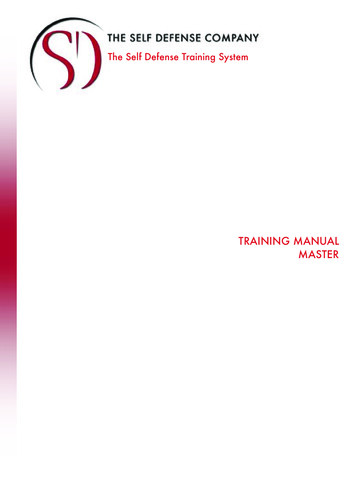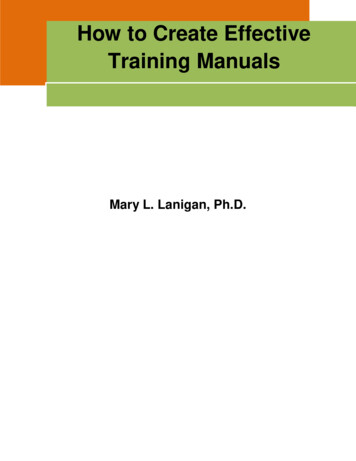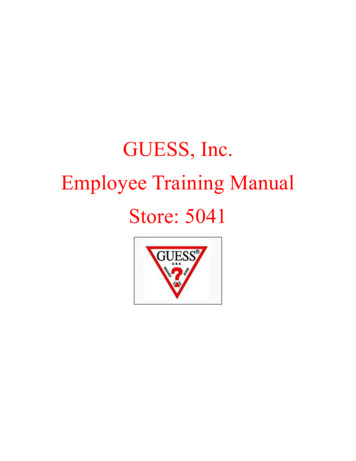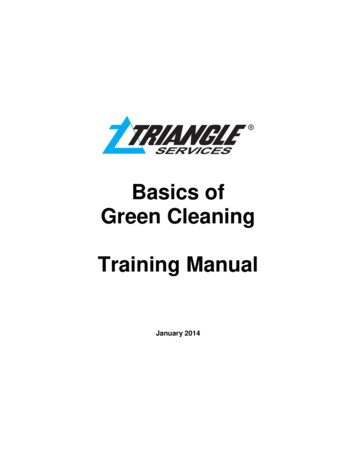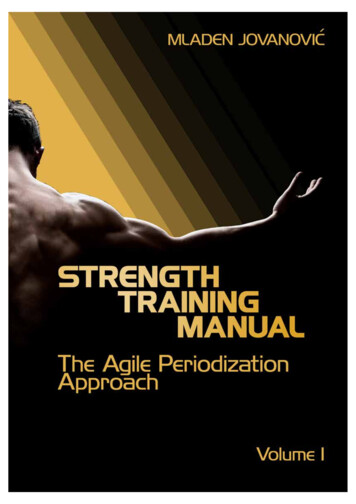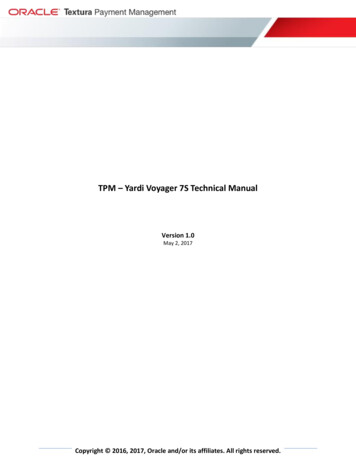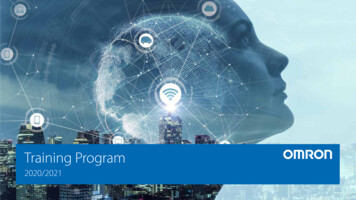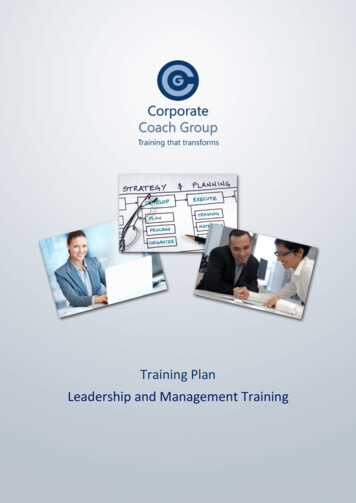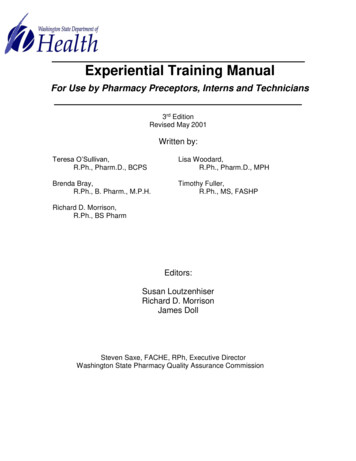
Transcription
Experiential Training ManualFor Use by Pharmacy Preceptors, Interns and Technicians3rd EditionRevised May 2001Written by:Teresa O’Sullivan,R.Ph., Pharm.D., BCPSLisa Woodard,R.Ph., Pharm.D., MPHBrenda Bray,R.Ph., B. Pharm., M.P.H.Timothy Fuller,R.Ph., MS, FASHPRichard D. Morrison,R.Ph., BS PharmEditors:Susan LoutzenhiserRichard D. MorrisonJames DollSteven Saxe, FACHE, RPh, Executive DirectorWashington State Pharmacy Quality Assurance Commission
AcknowledgementMany individuals and groups have assisted in the development of this manual bytheir participation in creating previous manuals, dating from 1973. Theirexperience and wisdom have been of benefit in creating this version. Ourheartfelt thanks is extended to all those who have contributed.ii
PrefaceThis third edition of the experiential training manual, formerly known as theInternship Manual, is presented in a new format to assist the preceptor, internand technician student identify subjects of importance. Utilizing their individualexpertise, several authors have addressed subjects from the concept of learningto the legal issues. Hopefully, this broad view will assist all parties involved tomaximize the experiential training phase of the intern or technician student’sprogram.The goal of the manual is to provide all the necessary forms and information tomake the intern or technician training a positive experience preparing theindividual for a career in pharmacy. It is also intended to satisfy the requirementsof Chapter 246-858 WAC.With the mandates from the Washington State Legislature regarding MedicationErrors and the Commission’s emphasis on patient counseling, it is theCommission’s hope that the tools identified in this manual will be beneficial tothe reader.iii
iv
Pharmacy Quality Assurance CommissionMission StatementThe mission of the Pharmacy Quality AssuranceCommission is to promote public health and safety byestablishing the highest standards in the practice ofpharmacy and to advocate for patient safety througheffective communication with the public, profession,Department of Health, Governor, and the Legislature.v
vi
Vision StatementThe Washington State Pharmacy Quality AssuranceCommission leads in creating a climate for the patientfocused practice of pharmacy as an integral part of anaccessible, quality–based health care system. As a result, the citizens of Washington State: Are well informed about medications; Take responsibility for their health; Utilize pharmacists and other health care providersappropriately; and Experience the highest level of health and wellness.vii
viii
Table of ContentsIntroduction . 11. Learning In The Experiential Setting . 32. Designing Experiential Learning. . 73. Implementing Experiential Learning . 114. Characteristics of Highly Effective Preceptors. . 175. The Challenges Of Being A Role Model . 256. Keeping the Lines Of Communication Open. . 337. Legal Issues In Precepting . 39References . 42Appendix . 43a. APHA Code of Ethics for Pharmacists .44b. Intern Competencies Forms . 45-48c. Publications .49d. Forms . 50-51ix
x
IntroductionYou are reading this manual because you have decided to become a preceptor or tocontinue precepting pharmacy students or technicians. We understand that it is unlikelythat you have had much (or even any) formal training in education, and that this makes itchallenging to design a learning environment where your students can thrive. Whatteaching techniques have been proven to optimize student learning? Which of thesetechniques work well in the experiential setting (where you teach) as opposed to theclassroom setting? How can you work an educational experience into a busy practiceenvironment? What are students looking for in an educational experience? What arestudents looking for in a preceptor? This manual has been designed by the WashingtonState Pharmacy Quality Assurance Commission, in conjunction with the two pharmacyschools in Washington State and a pharmacy technician training program, to help youanswer some of these questions.The goal of this educational program is to provide you with the tools that you need todesign quality experiential learning for the pharmacy student or technician that you teachin the practice environment. By the end of this program, you should be able to: differentiate between experiential and didactic learning; describe the challenges inexperiential learning that do not exist in the typical didactic learning environment. design an experiential learning plan that contains a clear learning goal, learningobjectives, and learning activities. implement the learning plan, identify and analyze problems that occur, and modifythe learning plan to address those problems. describe characteristics of excellent teachers; identify which of these characteristicsyou possess and which behaviors could be modified to make you a more effectivepreceptor. role model for your students’ quality practice activities that emphasize patient careand reduce the risk of medication errors. apply good communication techniques so that you can evaluate the quality of theexperiential learning that you are providing. answer the most frequently asked questions relating to legal issues in precepting. We heartily commend you on your decision to precept and realize that there may bemany reasons behind this choice. You may enjoy the stimulation and “update” in theform of discussions with students about therapeutic and practice-related issues. You mayhonour the memory of a pharmacist mentor who made a significant difference in yourprofessional career, appreciating the impact that a concerned and caring individual canhave in the life of a student. You may enjoy the challenge of helping students apply booklearning to real live patients or to the business of running a pharmacy. Whatever yourreason, you make a difference! The practice pearls that you give to your students will bepassed on to their students, as will your efforts to create a quality learning environment.In this way you are guaranteed a small measure of immortality: the knowledge that someof the things you teach will be passed on to and through future generations ofpharmacists.1
2
Chapter 1:Learning in the Experiential SettingLearning .We have all been doing it since the day we were born. We learned how to walk, to talk,and to ride a bike. We leaned to read, to write, and to do math. As time progressed, welearned medicinal chemistry, pharmacology, and pharmacotherapeutics. Some of ourlearning occurred in structured classroom settings, but much of our learning has occurredin unstructured environments. Learning in an unstructured environment is usually selfdirected: we recognize that we need to acquire some new skill or knowledge, and we setout to learn it. Many of the most valuable things that you know are things you havelearned outside of the classroom setting: how to drive a car, how to balance a checkbook,how to cook. These are skills that you use every day, and you acquired these skillsthrough self-directed learning in an unstructured environment. A special kind of selfdirected learning can occur in your practice setting and is called experiential learning.Experiential learning is defined as learning that occurs when a student is physicallyengaged in a professional activity with real consequences.1How is experiential learning different from classroom (didactic) learning? One notabledifference is that experiential learning more often involves one-on-one teaching thandoes classroom learning. In this way, experiential learning tends to be much more highlyindividualized to what the preceptor can teach and the student can learn, compared toclassroom learning. Another major difference is that the student primarily “learns bydoing” in an experiential setting. In the classroom setting, students can have the steps of askill explained to them, but they often don’t get to try the steps themselves right away. Alaboratory setting can provide skill performance right away, but laboratory time is limitedand so a student can learn a skill but cannot become proficient in that skill. Only in theexperiential setting can a student perform a skill over and over until true proficiencyoccurs.A third difference between experiential and classroom learning lies in the number ofdistractions. In a classroom setting, distractions are kept to a minimum and those minimaldistractions are usually somewhat controlled. In an experiential setting, learning isconstantly interrupted by distractions; this presents a unique challenge to the preceptor tomaintain a learning environment in spite of frequent and unanticipated interruptions.Finally, the role of a preceptor in an experiential setting differs from that of a teacher in aclassroom. A classroom teacher is mainly a describer of facts or skill steps. The preceptoris a teacher, a facilitator, and a mentor. In addition to the fact and skill teaching that ateacher does, the preceptor facilitates the learning process for the student by providing arich environment for the development of the knowledge, skills, attitudes and behaviors3
required of pharmacy professionals. The preceptor is also a mentor who advises, guides,and supports the student in his or her professional development.What is the role of the learner? An experiential learner has a responsibility to identifythat which he or she knows and that which needs to be learned; this is different from aclassroom setting where students are told what they need to know. The experientiallearner takes current skills, applies them to specific practice situations, observes theoutcome, modifies them if self-reflection or preceptor feedback advises that the outcomeis suboptimal, and thus grows in knowledge and skills to become a competentprofessional. A model of professional competence was developed by Nimmo andHolland:2 zation Attitudes Values JudgmentPractice withfeedbackReflection onpractice ProfessionalCompetenceThus we can see how the experiential learner develops the skills, professionalsocialization, and judgment to become a competent pharmacist. The experiential learningprocess presupposes a strong background in skills and, to some degree, professionalsocialization from previous didactic learning. While the areas of professionalsocialization and judgment are primarily learned in the experiential setting, psychomotor(development of physical skills) and problem solving skills acquired in the didacticsetting also continue to develop. Professional competence is thus born and honed duringexperiential learning. And when we really think about it, experiential learning doesn’tstop at the end of a degree program, for don’t we all continue to develop in these areas aspractitioners?Are all experiential learners created the same? No more so than all didactic learners. Youmay remember teachers you felt were excellent, but whom a colleague just couldn’t“connect” to. This is because that teacher taught in a style that met your learning needs,but not those of your colleague. It is helpful to understand how people learn. If you canfigure out how your student learns, then you can tailor your teaching to meet theirlearning style. Felder and Silverman3 have developed a model of learning style based onchemical engineering students, but which also applies to pharmacy students. Their modeldifferentiates learners as: sensing learners (concrete, practical, oriented toward facts and procedures) or intuitive learners (conceptual, innovative, oriented toward theories and meanings) visual learners (prefer visual representation of presented material – pictures,diagrams, flow charts) or verbal learners (prefer written and spoken explanations) active learners (learn by trying things out, working with others) or reflective learners (learn by thinking things through, working alone) sequential learners (linear, orderly, learn in small incremental steps) or globallearners (holistic, systems thinkers, learn in large leaps). 4
How do you like to learn? How do you like to teach? Can you diagnose how your studentlikes to learn? Discuss with your student how he or she learns best. Be mindful ofstructured learning and teaching opportunities that will enable you to provide learningexperiences in all types of styles, particularly if you are dealing with multiple learners(which automatically implies multiple learning styles).No matter what your teaching or learner’s style, there are four key steps in structuring thelearning process.Set Expectations. Clear expectations are important to both the learner and the preceptor.It starts with things as simple as where to be and when. It encompasses the student’s role,the preceptor’s role, the site role and the specific learning goals of the student. Thestudent and preceptor should sit down together, away from the practice site if possible,and discuss expectations and put them in written form for reference. It is important fromthe start of the experience to establish clear, open lines of communication. If at any time,expectations get muddied or off track, go back to the first step of assessing and clarifyexpectations.Motivate your Learner. Pharmacy students want to become pharmacists and technicianstudents want to become technicians or they wouldn’t last through the classroom work toarrive at your site. However, a student’s motivation in a particular learning environmentmay have little to do with his or her desire to be a pharmacist or technician and a lot to dowith the atmosphere of the environment. The things that motivate students aren’t reallydifferent from the basic needs that motivate all of us.Students want attention from a preceptor. The student wants to know that the preceptorcares about him or her and has a sincere desire to teach. Students strongly value sometime of undivided attention from their preceptor. Try to set aside time on a routine basisfor one-on-one discussion with your student, and then keep the appointment. When youask the student to research a question, remember to follow up the next day to discuss theinformation with the student.Students want to know that their work has relevance. If the student perceives anassignment as unimportant, he or she will be unmotivated to complete the job. Givestudents work that is truly important to the job at hand. Help the student to see therelevance of the work in their future practice. Listen to the student’s concerns aboutrelevance of their work.Students want satisfaction of a job well done. Make sure your students know that youappreciate their work. Tell them in both verbal and non-verbal ways. Help the student tounderstand how his or her work contributes to the work of the entire department ororganization. Help the student to understand the importance of his or her work in caringfor the patient (which we hope is why we are ultimately all in this profession).Provide Opportunities for Practice. The experiential learning process is all aboutpractice. The student needs to actually do the work and apply the knowledge that has5
been learned in the didactic setting. A student can have abundant knowledge, but unlesshe or she has the opportunity to put that knowledge into practice, professionalcompetence cannot be achieved. At this point, specific and measurable learningobjectives are important. The student needs to know what he or she is working towardand how that will be measured. As the student puts that knowledge into practice, it isimportant to realize that mistakes will happen and unanswered questions will arise.Provide the student the opportunity to reflect on the experiences and receive feedback.These are important steps to the continuous improvement of knowledge and skills in thedevelopment of professional competence.An important part of the opportunities you provide for practice will involve allowingyour student to progress gradually but continually toward their goal of becoming anindependent practitioner. This is especially true for pharmacy students. If you are anemployer and your intern training program stops when your pharmacy student is trainedto perform technician duties, then you will have a difficult time retaining students beyondtheir second year. Pharmacy students gravitate toward training programs that allow themto be performing many pharmacist duties by their final year of school (albeit under thesupervision of a licensed pharmacist). If you are a preceptor who employs interns, thentraining that provides pharmacist learning activities during the third and fourthprofessional years of school will be a vital part of your learning program.Give Structured Evaluation and Feedback. Evaluation and feedback are veryimportant to the experiential learning process, and this is really a two-way street. First,the preceptor needs to provide the student with an evaluation of performance. Again, thelearning objectives are important here. They should be specific and measurable so that itis clear what is being evaluated and how. Let the student know what positiveachievements have been made. Let the student know what learning objectives have notbeen achieved and develop a game plan for addressing those deficiencies.Likewise, the student should have the opportunity for self-evaluation as well asevaluation of the preceptor and site. An important step to the development of life-longlearning skills is the ability to reflectively evaluate one’s own work. The student needs toconsider his or her own performance and identify opportunities for improvement. Thestudent should also have the opportunity to evaluate the preceptor and site and providefeedback. This will aid your student in developing evaluative skills and help you andyour site to receive suggestions from students for experiential learning programimprovement.6
Chapter 2:Designing Experiential LearningDesigning a meaningful, quality learning experience involves more than just telling thestudent when and where to show up on the first day. Crucial to the process aredetermining the learning goal, learning objectives, and learning activities.Although writing a learning goal and learning objectives may seem like a tedious wasteof time, it is actually one of the most useful exercises that you as a preceptor can dotogether with your pharmacy or technician student. In a very real sense, the physical actof putting down on paper what you and your pharmacy or technician student want tolearn puts meaning into the learning activities that the student will do at your site. It alsosends a very tangible message to the student that you care about his or her learning. Bycaring enough to do this, you give your student attention, you give learning relevance tothe tasks which your student will perform, and you give the student a tool to measurelearning, which will lead to satisfaction (does this sound familiar?). You thus motivateyour student to learn! This exercise is as important to do with employees as it is withclerkship students. If you are not convinced of this, consider that the most commonreason that employees give for leaving a job is that they no longer feel stimulated by thatjob.Think about the process of writing a learninggoal and objectives as analogous to taking acar trip with someone and determining withthat person your intended destination. If you dothis after you’ve been driving around for sometime, you will waste a lot of time and energy.Writing your learning goal and objectivesbefore starting the learning experience allowsboth preceptor and student to determine thelearning destination. And it is important thatthe process be done together. To revisit the cartrip analogy, imagine getting into a car withsomeone and realizing quite some way into the drive that the driver is going in acompletely different direction from that in which you wanted to go. Avoid squabbles!Talk about those learning objectives in advance!One of the things both preceptors and students find difficult to understand is what alearning objective is, what a learning goal is, what a learning activity is, and how eachare different. The rest of this chapter will define and differentiate each of these.7
The Learning GoalA learning goal is a statement that summarizes in one sentence the “big picture” of whatyour student hopes to learn while at your site (job or practicum). Goal statements can usenon-quantifiable verbs such as assist, care for, establish, provide, give, help, know, andunderstand. For example, one student’s learning goal may be to understand how to dealwith electronic insurance claims, while another student’s goal may be to understand howa pharmacist-run anticoagulation service works. If your student is having difficultyarticulating a learning goal, ask him or her to tell you in one sentence what he or shehopes to be able to do by a certain time (e.g., by the end of the clerkship, before the nextperformance appraisal) that he or she cannot do now. Most of the time the sentence thatemerges will be a great learning goal.Writing Learning ObjectivesThe learning objectives, unlike the goal, should be specific. Learning objectives alsodiffer from learning goals and learning activities in that they are measurable. How?A learning objective contains aperformance (i.e., action) verb at thebeginning of the statement which defineshow that skill will be measured. To assistyou and your student in preparing thewording of your learning objectives, youwill find at the end of this chapter a tablecontaining categories of cognitive domainsin Bloom’s Taxonomy for CognitiveLearning Objectives, as well as verbs thatcorrelate well with each domain.Take a close look at this table if you have not seen it before. Notice how the taxonomyprogresses from the lowest levels of learning (knowledge and comprehension) at the topof the table to the highest levels of learning (synthesis and evaluation) at the bottom.Your student will likely be in the lower levels of learning (list, define, explain) during hisor her initial experiential education, but both you and your student should strive toprogress to higher levels of learning. Students who have learned at higher levels willbecome independent problem-solvers: something every employer and patient hopes for!As you help your student write his or her learning goal and potential learning objectives,keep in mind that learning entails gaining new skills. Ask your student to diagnose andarticulate his or her current ability and then define the level of skill he or she desires toattain. There should be a clear difference between the two. Don’t let the student chooseactivities that he or she already does well.Planning Learning ActivitiesThe next thing you and your student will need to think about is how to accomplish yourstudent’s learning objectives. As your student plans the journey between his or hercurrent skill level and the desired level of practice at the end of the rotation, you willprobably see several clearly delineated things to do. What your student should do is to8
write down each of these steps. They will become the list of activities that he or she willperform during the learning experience.Learning activities can include just about anything that will reasonably help your studentto reach his or her learning goal. One thing your student needs to strive for, however, isto avoid choosing passive learning activities. For example: a student who follows apreceptor quietly on rounds and never speaks unless spoken to misses the benefits thatoccur with active participation in the medication review of each patient. The benefits ofactive learning apply to learners at all levels. Even a beginning technician student willlearn far more from entering prescriptions into the computer by himself or herself as thetrainer looks on and gives directions, rather than watching the trainer enter theprescriptions.Differentiating Between Goals, Objectives And ActivitiesRemember that the difference between each of these lies in the wording of the statementsof and scope of the learning outlined. A learning goal is lofty and vague. A learningobjective is measurable and specific. A learning activity statement doesn’t adequatelyexplain how to measure the learning is that should take place, it just defines an activity. Itis common for students to mistake learning objectives and activities. Help themunderstand the difference.wordingscopeexamplelearning goalvaguelargeUnderstand how toprovide individualizedpatient care.learning objectiveMeasurableSpecificDesign a more efficient andfaster method to fill statorders than the one currentlyused.9learning activityunmeasurablenarrow, compared to goalAttend rounds. (there is noway in this statement tomeasure whether learninghas occurred)
Bloom’s Taxonomy for Cognitive Learning Objectives.Description of the Major Categoriesin the Cognitive Domain1. Knowledge. Knowledge is defined as the remembering of previously learnedmaterial. This involves recall of specific facts (e.g. being able to describe diseasestates or drug pharmacology), but does not imply any ability to use those facts toachieve desired outcomes. Knowledge represents the lowest level of learningoutcomes in the cognitive domain. Example: learner can define CHF and list thedrugs used to treat it.2. Comprehension. Comprehension is defined as the ability to grasp the meaningof material. This may be shown by translating material from one form to another(words to numbers), by interpreting material (explaining or summarizing), and byestimating future trends (predicting consequences or effects). These learningoutcomes go one step beyond the simple remembering of material. Example:learner can explain why drugs used to treat CHF should help to reducesymptomatology.3. Application. Application refers to the ability to use learned material in new andconcrete situations. This may include the application of such things as rules,methods, concepts, principles, laws, and theories. Learning outcomes in this arearequire a higher level of understanding than those under comprehension.Example: learner can modify doses of drugs used for an uncomplicated patientwith CHF.4. Analysis. Analysis refers to the ability to break down material into itscomponent parts so that its organizational structure may be understood. This mayinclude the identification of the parts, analysis of the relationships between parts,and recognition of the organizational principles involved. Learning outcomes hererepresent a higher intellectual level than comprehension and application becausethey require an understanding of both the content and the structural form of thematerial. Example: given a list of information about a patient’s medications,multiple disease states, and symptoms, a learner can distinguish the use of eachmedication and identify therapies that may be suboptimal.5. Synthesis. Synthesis refers to the ability to put parts together to form a newwhole. This may involve the production of a unique communication (seminar), aplan of operation (research proposal), or a set of abstract relations (scheme forclassifying information). Learning outcomes in this area stress creative behaviors,with major emphasis on the formulation of new patterns or structures. Example:learner can modify a suboptimal treatment regimen of any patient with selectedmultiple disease states.6. Evaluation. Evaluation is concerned with the ability to judge the value ofmaterial for a given purpose, based on definite criteria. These may be internalcriteria (organization) or external criteria (relevance to the purpose) and thestudent may determine the criteria or be given them. Learning outcomes in thisarea are highest in the cognitive hierarchy because they contain elements of all ofthe other categories, plus conscious value judgment based on clearly definedcriteria. Example: learner can independently assess efficacy and toxicity of allmedications for any patient; this learner could be a case manager.Adapted from reference 4.10Illustrative Verbs forSpecific Learning Objectivesdefine, describe, identify,label, list, locate, match, name,outline, reproduce, select, statecombine, compute, convert,distinguish, estimate, explain,extend, generalize, giveexample, infer, paraphrase,rewrite, summarizeapply, change, classify,demonstrate, manipulate,modify, operate, perform,predict, provide, relate, show,solveanalyze, detect, diagram,differentiate, distinguish,identify, illustrate, infer, relate,select, separate, subdividecompose, create, devise,design, generate, modify,organize, plan, produce,rearrange, reconstruct, relate,reorganize, revise, writeappraise, assess, contrast,criticize, decide, evaluate,judge, justify, interpret,measure, relate, support
Chapter 3:Implementing Experiential LearningAfter becoming familiar with how students learn and once learning objectives have beenestablished for a particular pharmacy site, then the fun can begin! It is in theimplementation of the learning objectives that students begin their professionaldevelopment and gain confidence in providing pharmacy services. Remember, the roleof the preceptor
maximize the experiential training phase of the intern or technician student’s program. The goal of the manual is to provide all the necessary forms and information to make the intern or technician training a positive experience preparing the individual for a career in pharmacy

